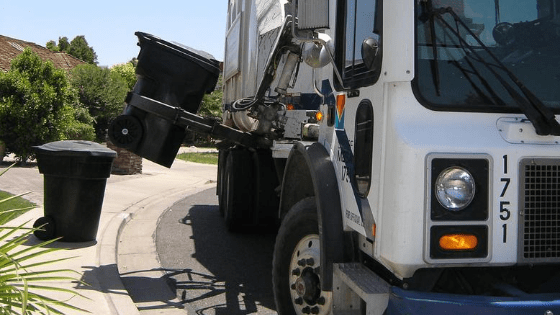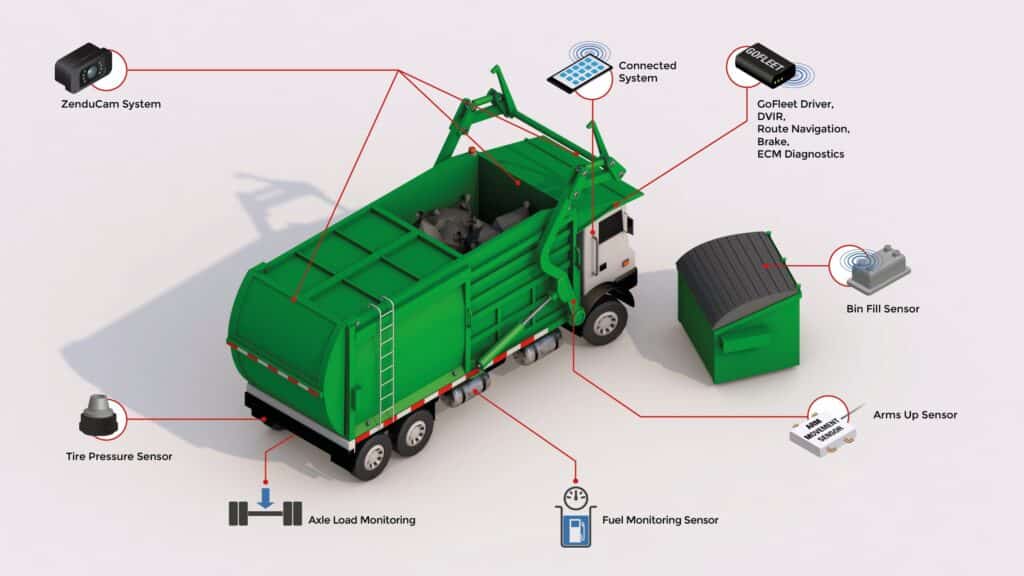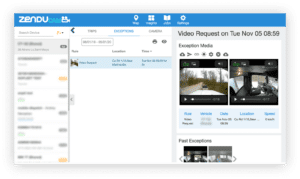Telematics Becoming Critical To Improving Company Initiatives In Waste Disposal
August 11, 2020
As a business grows, new initiatives are often put in place to help better the company. When it comes to waste disposal, fleets are typically looking to accomplish initiatives related to their environmental impact, worker morale, and promoting accountability in corporate culture. To successfully meet all of these initiatives, having a 360 telematics solution is critical.
Using a 360 Solution to Help Initiatives in Waste Disposal Fleets
Below we discuss the three initiatives listed previously and how a 360 telematics solution like the one displayed above can help.
Using GPS and Engine Tracking for Environmental Initiatives
Currently, many corporations have focused their attention on improving their impacts on the environment. However, many businesses struggle to find a balance between reducing their adverse effects and maintaining productivity.
But even the smallest of steps can leave a big impression.
Waste disposal fleets are finding that GPS and engine tracking telematics solutions can be used to improve their work efforts AND reduce their environmental impact. Using a GPS and engine tracking solution allows public and private fleets to monitor geographic operations. Meaning, they can track when vehicles are idling and speeding (two of the most prominent causes of greenhouse gas emissions) and even set up alerts to notify drivers of when they are releasing more emissions than they have to. This problem is critical to address as idling for even 4 hours a day not only releases more emissions than necessary but also uses up to 27 million gallons of excess fuel each year. GPS and engine tracking solutions can help fleets reduce high-emission actions by up to 20%.
These GPS solutions are designed to coordinate route effectiveness, so only the most efficient route (in terms of completing work faster or with less resources) is taken.
For private fleets that are hired and paid by businesses, sensors that allow for GPS connectivity are praised for making work efficient and optimized. In this instance, fill level sensors can be placed on bins to monitor how full a bin is becoming—alerting drivers when the content quantity is at least 80% full while automatically adding it to an optimized disposal route. Meaning, only bins that need to be emptied are serviced. This significantly saves resources and lowers environmental impacts.
Using Smart Camera and Training Solutions for Workforce and Worker Morale Initiatives
Another initiative that many waste disposal fleets are finding telematics useful for, is improving their workforce and worker morale. When smart camera systems are installed, teams are able to monitor everything that is happening on the road as the camera records and stores footage on the cloud in addition to transmitting a live feed of the route. Having these solutions in place can allow managers to investigate previous driving incidents or complaints and see how new hires are absorbing training material.
When it comes to training, the camera solution can also monitor how all drivers are performing, prompting managers to assign refresher training courses to those who need it. This is possible as the camera solution will record and monitor how the driver is behind the wheel—noting any unsafe, dangerous or ineffective incidents such as speeding, tailgating, or appearing distracted. This also makes assigning training modules easy. For example, suppose a driver triggers the alert for speeding 25 times within a week. An online digital training platform can automatically assign a training assignment and note the training course in their driver profile. Not to mention that the training platform can be used to praise and reward those who are following driving protocol.
It should also be noted that dash camera video recordings can be used and inserted into future training modules. Meaning teachings for unique or hard to maneuver situations can improve drastically the more a fleet is in operation with camera and training solutions.
Using Smart Camera Solutions and Sensors to Promote Accountability
A final initiative that many fleets are currently working towards, is the initiative of promoting accountability in their corporate culture. Currently, fleets are doing this by installing smart camera solutions and sensors that allow management teams to investigate driving incidents properly.
When a smart camera system is installed, the cameras can record driver actions, company vehicles, and civilians or pedestrians to confirm reported driving events. Typically, fleets use these telematics solutions to resolve complaints about unemptied residential curbside waste bins. An example is when something is blocking the bin, which makes it too dangerous to service. With a camera in place, drivers can press the alert button to capture the unique circumstance so managers can review the footage.
Additionally, when vehicles are paired with sensors that are installed on movable vehicle parts (such as arms and packer panels or doors), incident reconstruction can happen. Installing sensors can allow for data to show when movable vehicle parts are in motion. Suppose there was an incident regarding vehicle arm movement while driving through a narrow alleyway to empty a bin. In that case, the sensors could record when the arms moved and whether it was during the time frame of the vehicle being within the alleyway. The sensors can also monitor when the packer panels open and close. Allowing for more insight to when litter or debris escapes the packer during travel or rollover accidents.
A 360 telematics solution can help nearly any fleet improve. When it comes to waste disposal, fleets can directly target key company initiatives relating to their environmental impact, employee training, driver morale, and company accountability. If you’re interested in learning more about how your company can use a 360 solution to your advantage, contact us today to speak to one of our consultants.





